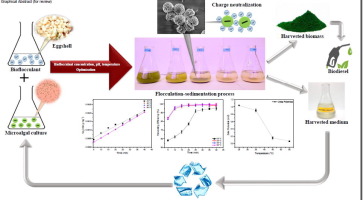Bioresource Technology ( IF 11.4 ) Pub Date : 2020-03-23 , DOI: 10.1016/j.biortech.2020.123205 Madonna Roy , Kaustubha Mohanty

|
Waste eggshell-derived bioflocculant was used for harvesting T. obliquus in a circular bioeconomy approach. It was found that 120 mg L-1 bioflocculant can flocculate 98.62±0.43% of T. obliquus cells within 25 minutes at optimal pH 4.0 and temperature 35 °C. The influence of bioflocculant concentration, pH and temperature on zeta potential was evaluated to understand the flocculation mechanism. Microscopic and FESEM-EDX images were analyzed to evaluate the microalgal structural changes. Adsorption mechanism of bioflocculant over the microalgal cells was determined by performing adsorption kinetic studies. Pseudo-second order kinetic model was a suitable fit for the data obtained from the experiments, which indicated chemisorption as the probable mechanism. The spent medium recovered after harvesting process was successfully recycled for subsequent cultivation of T. obliquus, thus reducing the dependency on fresh medium. The FAME composition of the biomass treated with bioflocculant was not altered.
中文翻译:

废蛋壳衍生的生物絮凝剂用于斜背山毛榉的收获的平衡化:工艺优化,动力学研究和用于循环生物经济的废培养基的可回收性
废蛋壳衍生的生物絮凝剂用于通过循环生物经济方法收获斜纹棉球菌。结果发现,120毫克的L -1生物絮凝剂可絮凝的98.62±0.43%T.斜在最佳pH 4.0和温度35°C下的25分钟内收集细胞。评估了生物絮凝剂浓度,pH和温度对zeta电位的影响,以了解絮凝机理。分析了显微图像和FESEM-EDX图像,以评估微藻的结构变化。通过进行吸附动力学研究确定了生物絮凝剂在微藻细胞上的吸附机理。伪二级动力学模型非常适合从实验中获得的数据,表明化学吸附是可能的机理。收割后回收的废培养基被成功地回收利用,用于随后的斜叶锥虫培养,从而减少了对新鲜培养基的依赖。用生物絮凝剂处理过的生物质的FAME组成没有改变。



























 京公网安备 11010802027423号
京公网安备 11010802027423号